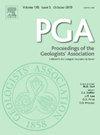具有特殊科学价值的地点:它们在保护英格兰地质遗产中的作用和重要性
IF 1.3
4区 地球科学
Q2 Earth and Planetary Sciences
引用次数: 0
摘要
《国家公园和进入农村法》(1949年)是英国第一部全国性的自然保护立法,其中规定,为了自然保护的目的,根据其植物、动物、地质或地理(地貌)特征,指定具有特殊科学价值的地点。虽然经常被错误地认为仅仅是保护动植物的一种手段,但在英国,特殊地理区域仍然是保护和管理国内和国际上重要的地质和地貌特征的主要机制。75年过去了,在当前的威胁和压力下,人们提出了关于它们如何保护动植物的问题,探索了sssi在保护英国地质遗产亮点方面的作用和有效性。描述了地质/地貌学意义上的sssi的重要性,它们的起源、特征和工作方式,以及它们面临的威胁和压力。本文描述了英格兰1221个现有的地质/地貌特殊地理区域的状况,并讨论了现有特殊地理区域立法和政策的优缺点,从而得出结论:特殊地理区域在保护英格兰的地质遗产方面一直非常有效,而且仍然非常有效。任何未来的特殊地点改革都应该承认、建立和庆祝地质/地貌特殊地点的成功,并提供一个机会,在政府政策中提高地质保护的形象,并为特殊地点系列提供未来的保障。例如,简化更新特别重要地理位置描述和地点边界的过程,将更容易适应科学认识的进步,并对自然过程导致的地质/地貌特征的物理重新定位作出反应。本文章由计算机程序翻译,如有差异,请以英文原文为准。
Sites of Special Scientific Interest: Their role and importance in conserving England's geoheritage
The National Parks and Access to the Countryside Act (1949), the first national nature conservation legislation in Great Britain, included provision to designate, for the purpose of nature conservation, Sites of Special Scientific Interest (SSSIs) on account of their flora, fauna, geological or physiographical (geomorphological) features. Although often incorrectly perceived only as a means of conserving flora and fauna, SSSIs remain the primary mechanism for conserving and managing nationally and internationally important geological and geomorphological features in Great Britain. Seventy-five years on, and with questions being raised about how well they conserve flora and fauna given current threats and pressures, the role and effectiveness of SSSIs in conserving the highlights of England's geoheritage are explored. The importance of geological/geomorphological SSSIs, their origin, character, and workings, and the threats and pressures they face are described. The condition of the 1221 existing geological/geomorphological SSSIs in England is described and the strengths and weaknesses of existing SSSI legislation and policy are discussed, leading us to conclude that SSSIs have been, and remain, extremely effective in conserving England's geoheritage. Any future SSSI reform should recognise, build upon and celebrate the success of geological/geomorphological SSSIs, and would provide an opportunity to raise the profile of geoconservation in government policy and to futureproof the SSSI series. For example, simplifying the process for updating SSSI descriptions and site boundaries would make it easier to accommodate advances in scientific understanding and respond to the physical repositioning of geological/geomorphological features resulting from natural processes.
求助全文
通过发布文献求助,成功后即可免费获取论文全文。
去求助
来源期刊
CiteScore
2.70
自引率
8.30%
发文量
54
审稿时长
6-12 weeks
期刊介绍:
The Proceedings of the Geologists'' Association is an international geoscience journal that was founded in 1859 and publishes research and review papers on all aspects of Earth Science. In particular, papers will focus on the geology of northwestern Europe and the Mediterranean, including both the onshore and offshore record. Following a long tradition, the PGA will focus on: i) a range of article types (see below) on topics of wide relevance to Earth Sciences ii) papers on aspects of Earth Science that have societal relevance including geoconservation and Earth management, iii) papers on palaeoenvironments and palaeontology of the Mesozoic and Cenozoic, iv) papers on aspects of Quaternary geology and climate change, and v) papers on the history of geology with particular reference to individuals that have shaped the subject. These topics will also steer the content of the themes of the Special Issues that are published in the PGA.

 求助内容:
求助内容: 应助结果提醒方式:
应助结果提醒方式:


